Understanding Qualcomm's Snapdragon 810: Performance Preview
by Joshua Ho & Andrei Frumusanu on February 12, 2015 9:00 AM EST- Posted in
- SoCs
- Qualcomm
- Mobile
- Gobi
- Snapdragon 810
CPU/System Performance
While talking about the energy aware scheduler and various other aspects of the Snapdragon 810 is helpful to understand how the SoC works, ultimately we must look at performance to determine whether Qualcomm's work to differentiate their SoC was worthwhile or not. To do this, we ran Qualcomm's tablet Mobile Development Platform (MDP) through our standard suite of benchmarks, although I was unable to run benchmarks such as BaseMark X and PCMark due to odd issues with the tablet.
Starting off, we have a complete breakdown of GeekBench 3 scores. The scores are closer to theoretical performance than real-world performance, but it's very useful for highlighting architectural changes. For our look at GeekBench we are comparing the 810 reference platform to our results from our recent Galaxy Note 4 Exynos review, along with results for the Snapdragon 805-based Galaxy Note 4 taken from the GeekBench database.
| GeekBench 3 - Integer Performance | |||||||
| Snapdragon 805 (ARMv7) | Exynos 5433 (AArch32) | Snapdragon 810 (AArch64) | S810 > S805 % Advantage | ||||
| AES ST | 85.4 MB/s | 1330 MB/s | 604.9 MB/s | 608% | |||
| AES MT | 350.4 MB/s | 4260 MB/s | 3050MB/s | 770% | |||
| Twofish ST | 94.0 MB/s | 81.9 MB/s | 85.7 MB/s | -8.8% | |||
| Twofish MT | 329.8 MB/s | 440.5 MB/s | 448.5 MB/s | 36% | |||
| SHA1 ST | 202.1 MB/s | 464.2 MB/s | 428.1 MB/s | 112% | |||
| SHA1 MT | 806.1 MB/s | 2020 MB/s | 3019 MB/s | 275% | |||
| SHA2 ST | 95.1 MB/s | 121.9 MB/s | 81 MB/s | -15% | |||
| SHA2 MT | 367.3 MB/s | 528.3 MB/s | 393.4 MB/s | 7.1% | |||
| BZip2Comp ST | 4.46 MB/s | 4.88 MB/s | 4.99 MB/s | 12% | |||
| BZip2Comp MT | 15.5 MB/s | 19.3 MB/s | 20.5 MB/s | 32% | |||
| Bzip2Decomp ST | 6.43 MB/s | 7.41 MB/s | 7.99 MB/s | 24% | |||
| Bzip2Decomp MT | 21.7 MB/s | 29.7 MB/s | 30.8 MB/s | 42% | |||
| JPG Comp ST | 20.4 MPs | 19.3 MPs | 18.9 MP/s | -7.4% | |||
| JPG Comp MT | 79.9 MP/s | 88.8 MP/s | 88.9 MP/s | 11% | |||
| JPG Decomp ST | 30.6 MP/s | 43.5 MP/s | 36.3 MP/s | 19% | |||
| JPG Decomp MT | 115.7 MP/s | 149.6 MP/s | 182.7 MP/s | 58% | |||
| PNG Comp ST | 0.82 MP/s | 1.11 MP/s | 1.11 MP/s | 35% | |||
| PNG Comp MT | 3.01 MP/s | 4.57 MP/s | 4.78 MP/s | 59% | |||
| PNG Decomp ST | 18.7 MP/s | 19.1 MP/s | 15.6 MP/s | -17% | |||
| PNG Decomp MT | 63.7 MP/s | 78.8 MP/s | 94.1 MP/s | 48% | |||
| Sobel ST | 39.2 MP/s | 58.6 MP/s | 53.3 MP/s | 36% | |||
| Sobel MT | 128 MP/s | 221.3 MP/s | 248.4 MP/s | 94% | |||
| Lua ST | 0.92 MB/s | 1.24 MB/s | 1.30 MB/s | 41% | |||
| Lua MT | 1.36 MB/s | 2.48 MB/s | 5.93 MB/s | 336% | |||
| Dijkstra ST | 4.46 Mpairs/s | 5.23 Mpairs/s | 3.38 Mpairs/s | -24% | |||
| Dijkstra MT | 13.2 Mpairs/s | 17.1 Mpairs/s | 13.7 Mpairs/s | 3.8% | |||
Thanks in large part to the new cryptographical capabilities of the ARMv8 cores, Snapdragon 810 gets off to a very good start in GeekBench 3's integer benchmarks. Once we move on to the rest of our benchmarks, we find that 810 continues to hold a considerable advantage through most of these benchmarks; BZip2 decompression, Lua script performance, and JPEG decompression all show considerable performance gains over the Snapdragon 805 based Galaxy Note 4. Snapdragon 810's overall performance improvement here is a rather large 45%, though if we throw out the especially large gains that come from Lua MT, the overall performance advantage is closer to 30%.
There are a few cases where performance regresses however, including in PNG decompression and Dijkstra's algorithm. This could be a result of memory performance (more on that later) or architectural differences. It's worth pointing out that these cases are also among the only cases where Snapdragon 810 notably trails the Exynos 5433.
| GeekBench 3 - Floating Point Performance | |||||||
| Snapdragon 805 (ARMv7) | Exynos 5433 (AArch32) | Snapdragon 810 (AArch64) | S810 > S805 % Advantage |
||||
| BlackScholes ST | 4.33 Mnodes/s | 4.37 Mnodes/s | 5.01 Mnodes/s | 16% | |||
| BlackScholes MT | 17.0 Mnodes/s | 20.4 Mnodes/s | 25.5 Mnodes/s | 50% | |||
| Mandelbrot ST | 0.87 GFLOPS | 1.14 GFLOPS | 1.20 GFLOPS | 38% | |||
| Mandelbrot MT | 3.45 GFLOPS | 5.09 GFLOPS | 6.41 GFLOPS | 86% | |||
| Sharpen Filter ST | 886 MFLOPS | 1030 MFLOPS | 1007 MFLOPS | 14% | |||
| Sharpen Filter MT | 3.54 GFLOPS | 4.31 GFLOPS | 5.02 GFLOPS | 42% | |||
| Blur ST | 1.18 GFLOPS | 1.27 GFLOPS | 1.26 GFLOPS | 6.8% | |||
| Blur MT | 4.67 GFLOPS | 5.03 GFLOPS | 6.14 GFLOPS | 31% | |||
| SGEMM ST | 2.82 GFLOPS | 1.81 GFLOPS | 2.29 GFLOPS | -19% | |||
| SGEMM MT | 8.05 GFLOPS | 6.1 GFLOPS | 6.12 GFLOPS | -24% | |||
| DGEMM ST | 0.81 GFLOPS | 0.57 GFLOPS | 1.03 GFLOPS | 27% | |||
| DGEMM MT | 2.69 GFLOPS | 2.29 GFLOPS | 2.81 GFLOPS | 4.5% | |||
| SFFT ST | 1.16 GFLOPS | 1.1 GFLOPS | 1.25 GFLOPS | 7.8% | |||
| SFFT MT | 4.55 GFLOPS | 4.56 GFLOPS | 4.11 GFLOPS | -9.7% | |||
| DFFT ST | 0.47 GFLOPS | 1.02 GFLOPS | 1.03 GFLOPS | 119% | |||
| DFFT MT | 1.89 GFLOPS | 3.46 GFLOPS | 2.97 GFLOPS | 57% | |||
| N-Bod ST | 331.5 Kpairs/s | 370.4 Kpairs/s | 486.6 Kpairs/s | 47% | |||
| N-Bod MT | 1.12 Mpairs/s | 1.44 Mpairs/s | 1.72 Mpairs/s | 54% | |||
| Ray Trace ST | 1.48 MP/s | 1.7 MP/s | 1.73 MP/s | 17% | |||
| Ray Trace MT | 5.77 MP/s | 6.65 MP/s | 8.16 MP/s | 41% | |||
GeekBench's floating point performance shows a similar range of performance increases. More often than not multi-threaded performance gains exceed single-threaded performance gains, which is a hopeful sign for how well the Snapdragon 810 reference platform can hold up when all four big cores are being hammered. Otherwise the 810 shows considerable performance gains on almost every benchmark here, the sole exception being SGEMM performance.
In this case Snapdragon 810 performance is relatively close to Exynos 5433 performance even though it has the advantage of running in AArch64 mode, which should give the FP numbers a boost over the Exynos. The SGEMM test is likely an isolated case where the Krait architecture and Snapdragon 805's high clock speed play to its favor. The overall Snapdragon 810 performance improvement is 30%, almost exactly what we saw with GeekBench integer performance as well (after throwing out Lua MT).
| GeekBench 3 - Memory Performance | ||||||
| Snapdragon 805 (ARMv7) | Exynos 5433 (AArch32) | Snapdragon 810 (AArch64) | S810 > S805 % Advantage |
|||
| Stream Copy ST | 8.37 GB/s | 5.56 GB/s | 6.02 GB/s | -28% | ||
| Stream Copy MT | 10.2 GB/s | 5.80 GB/s | 7.57 GB/s | -26% | ||
| Stream Scale ST | 5.17 GB/s | 4.98 GB/s | 6.61 GB/s | 28% | ||
| Stream Scale MT | 8.05 GB/s | 5.77 GB/s | 7.37 GB/s | -8.4% | ||
| Stream Add ST | 5.06 GB/s | 4.85 GB/s | 5.64 GB/s | 11% | ||
| Stream Add MT | 7.46 GB/s | 5.72 GB/s | 6.62 GB/s | -11% | ||
| Stream Triad ST | 5.37 GB/s | 4.82 GB/s | 5.6 GB/s | 4.3% | ||
| Stream Triad MT | 8.20 GB/s | 5.73 GB/s | 6.63 GB/s | -19% | ||
Usually we don't like to post the GeekBench memory scores, but in this case there is an interesting phenomenon going on with the Snapdragon 810. Although the LPDDR4 memory running at 1555MHz gives the SoC a large advantage in memory bandwidth over the Exynos 5433 and runs its CCI at 787 MHz, giving the CPU port a theoretical 12.6 GB/s that's much more than the 6.6GB/s of the 5433, the actual measured bandwidth difference is much less and is nowhere near that figure in any of the sub-tests.
To look at this in more detail, we use AndEBench's memory benchmarks, and indeed we see a similar result.
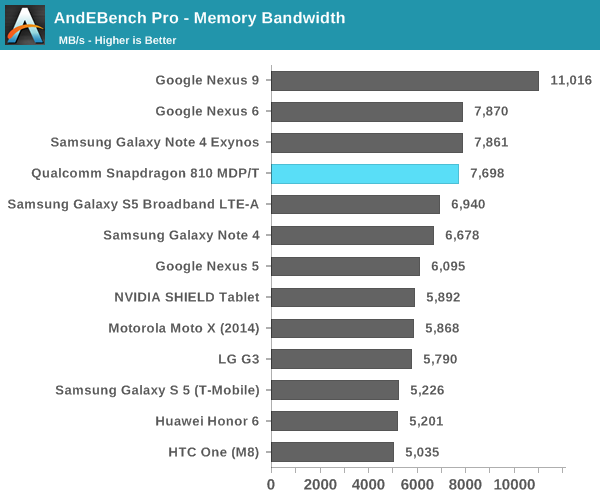
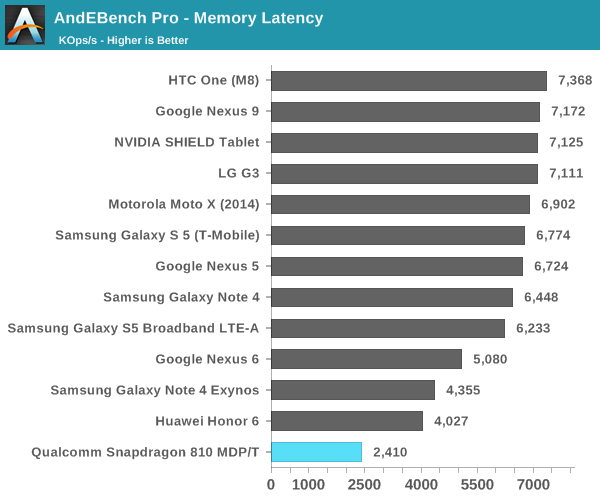
It's the memory latency test in particular that's very worrisome, as the MDP tablet achieves a very bad throughput score. We're not sure why this happens, but we hope to investigate this further in the future when we get the chance to review a shipping Snapdragon 810 device.
Continuing on, let's look at our browser bench suite.
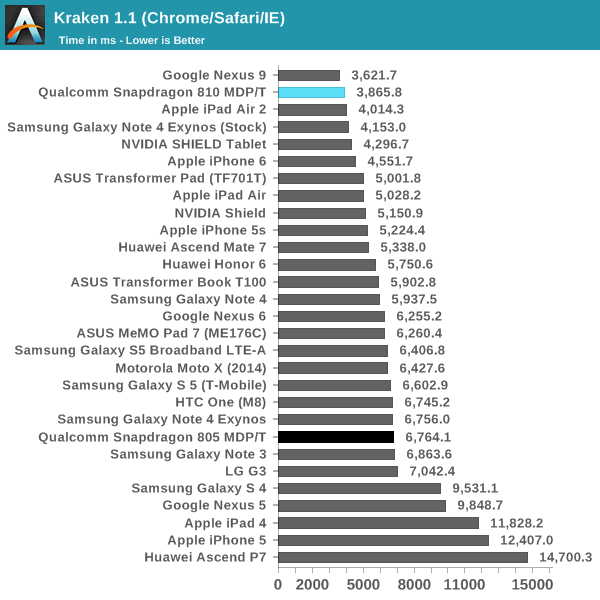
Here, the Snapdragon 810 is off to quite a start. While not a direct correlation, performance in these benchmarks can generally be correlated with CPU performance. The Snapdragon 810 shines here and approaches the Nexus 9, which has a strong showing due to the underlying Denver CPU's code optimizer unrolling loops in the benchmark.
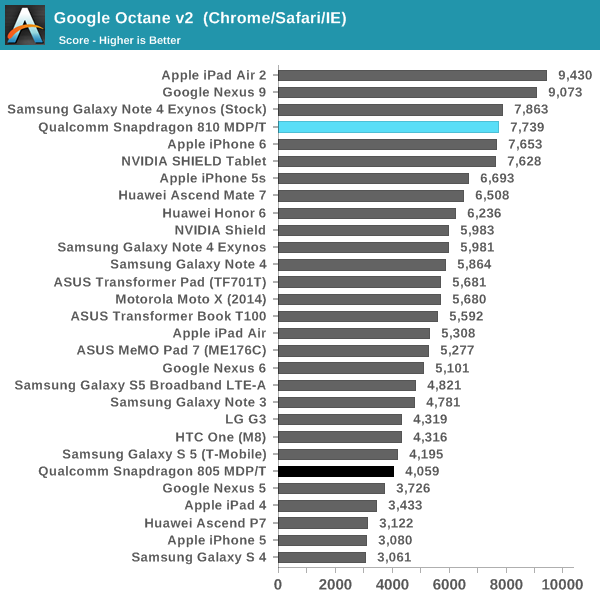
In Octane, we see that the Snapdragon 810 continues to be competitive with some of the fastest SoCs available today.
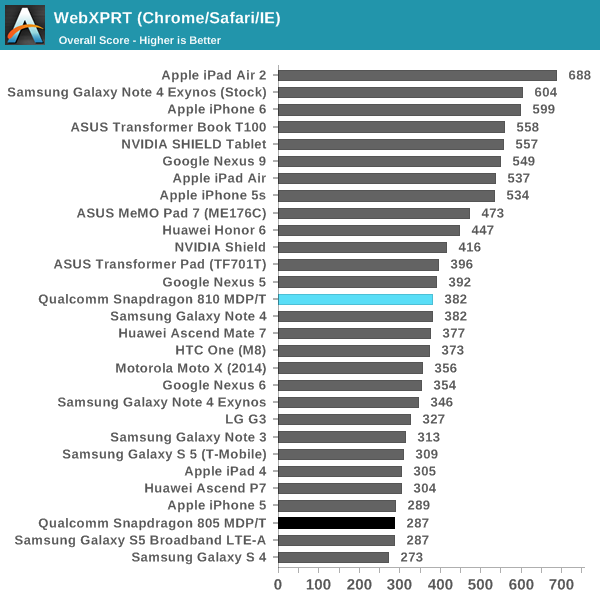
On the other hand, in WebXPRT we see that performance ends up somewhere around the level of the Snapdragon 801. It's possible that we're looking at thermal throttling or some other issue here as I was unable to run multiple trials of this test. Our browser based tests are otherwise generally consistent with what we found earlier this week on the A57-based Exynos 5433, so it's unlikely we're looking at an unoptimized Chrome build.
Continuing with the benchmarks we were able to perform at the performance preview, BaseMark OS II is next.
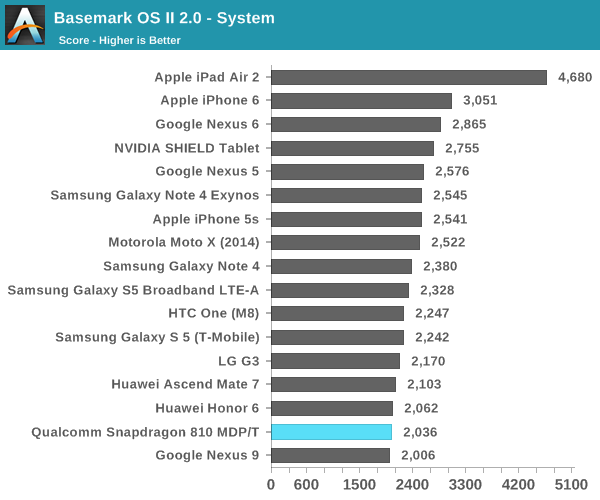
The System numbers of the Snapdragon 810 MDP/T seem disappointing, as it falls at the lower end of our current flagship device lineup. It seems the reference platform isn't as well optimized as it should be.
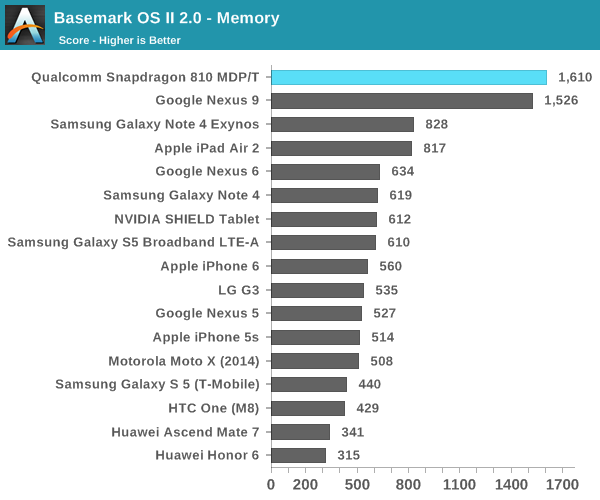
Similar to the Nexus 9, we see some odd trends in the memory tests. It isn't quite clear what's causing this, but a performant eMMC is certainly a possibility. Due to this test being very device specific, we can't really judge the Snapdragon 810's performance here.
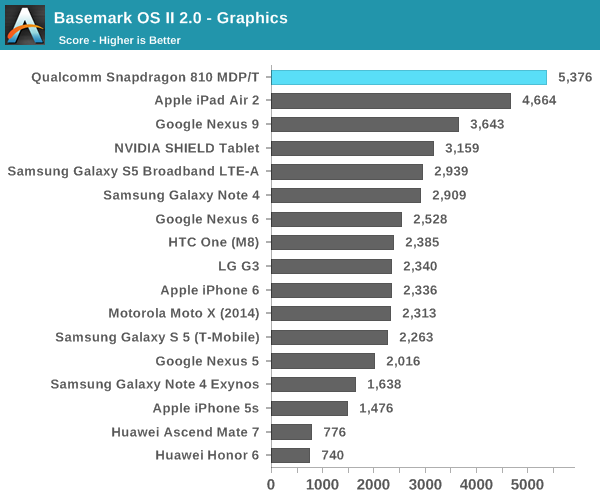
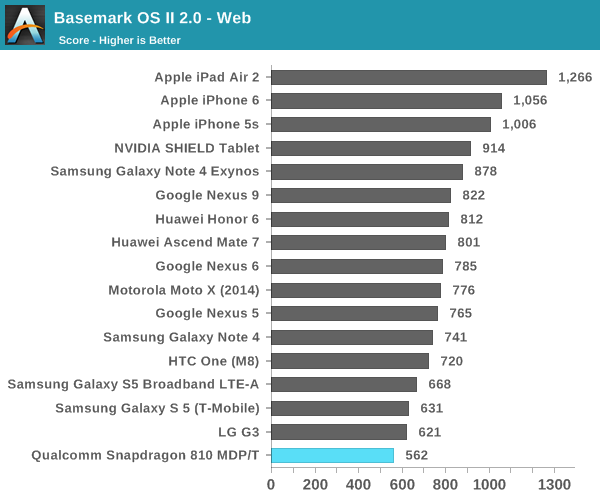
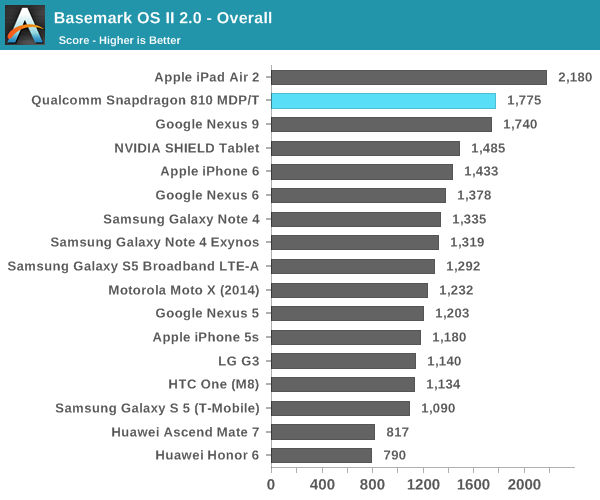
As for BaseMark, what we get are very binary results with the 810 either coming in near the top or bottom. The overall score still looks quite good as a result, boosted by things such as chart-topping graphics performance. On the other hand the web and system scores are struggling, coming in 20% or more behind the Note 4 and it's A57 based Exynos 5433. Since this is an early device this may be a case of early teething issues with performance, possibly with optimizations or the OS, but at this point in time it's difficult to confirm anything.
Meanwhile looking at how Qualcomm's reference platform compares to the Snapdragon 805-based Nexus 6, we find some significant performance gains at times. Though Krait has held up admirably against its A15 based competition, A57 finally provides a solid jump in performance over what even the fastest Krait can offer.










119 Comments
View All Comments
phoenix_rizzen - Thursday, February 12, 2015 - link
Asus ZenPhone 2 uses an Intel chipset.There's a couple of other ones as well.
blanarahul - Thursday, February 12, 2015 - link
It's probably at Snapdragon 800 level. Intel won't compete with S810 and best Exynos' of the world until Airmont.... Well, atleast I hope so. *sigh*serendip - Friday, February 13, 2015 - link
Intel on Android also has problems with app compatibility and speed, despite Intel's assurances to the contrary. Apps with ARM-compiled native codeserendip - Friday, February 13, 2015 - link
Apps with ARM-compiled native code either don't run or run slowly under the code translator. It's almost like Intel is giving away these phone and tablet Atom SOCs to get a foot in the mobile market. I'm quite happy with my cheap Windows 8.1 tablet but Android on Intel has a way a to go yet.(the lack of comment editing isn't fun, especially when the Submit Comment button is so easy to click)
phoenix_rizzen - Friday, February 13, 2015 - link
That's for (mainly) games developed using the Android NDK, correct? Doesn't the switch to the Android RunTime (ART) and pre-compiling the apps at install time mitigate this? Or does ART not apply to NDK apps?jjj - Thursday, February 12, 2015 - link
Look at the phrasing from 2 articles at just a few days distancein this one - Thanks in large part to the new cryptographical capabilities of the ARMv8 cores, Snapdragon 810 gets off to a very good start in Geekbench 3's integer benchmarks ....Snapdragon 810's overall performance improvement here is a rather large 45%, though if we throw out the especially large gains that come from Lua MT, the overall performance advantage is closer to 30%.
and from the Note 4 - GeekBench's integer benchmarks paint a similar picture - if we disregard the huge boost to the cryptography scores we see an average advantage of 31% for the Exynos 5433's A57 cores, or 29% when we normalize for clock speeds.
So for the Note they clearly point out and discard the encryption gains and they normalize for clocks. That's good and fair and the proper way to look at it. (although quantifying the importnace of the encryption gains would be a plus).
Here not only encryption is left alone but clocks are not even mention, some readers might not be even aware that there is a clock difference.
The tone and objectivity are fundamentally different, a nice review for the Note while here it's all about easing concerns and making SD810 look good.
Sushisamurai - Thursday, February 12, 2015 - link
+1. It's not unethical, because it's on a reference platform that Qualcomm is sourcing out. It'd be "unethical" (your terms, not mine - I would use the word disappointing) if they didn't give investigate throttling and power for actual, retail/shipping devices. But I haven't been disappointed yet so....gonchuki - Friday, February 13, 2015 - link
2015 was already going to be a good skip year with flagships already going full retard at 6'' in late 2014 and already gimping the specs of 5'' phones just to increase the sales of their higher margin phablets.Andrei Frumusanu - Thursday, February 12, 2015 - link
I added the clocks for the CPU, apologies the article was still being edited when published.As for power and thermals, we have no way to test these until we get a shipping review device with the SoC. Josh had only a couple of hours on hand with the MDP, making more extensive testing not possible. Calling that unethical is pretty harsh.
warreo - Thursday, February 12, 2015 - link
Andrei, power and thermals aside, I notice you didn't address why there was not a greater focus on Exynos vs. S810? At bare minimum, you should include the % difference in the table in addition to the difference vs. S805. The absence of any kind of discussion there makes it easy for people to cry unethical, NOT the absence of power and thermals, which as you said, was due to lack of testing time.